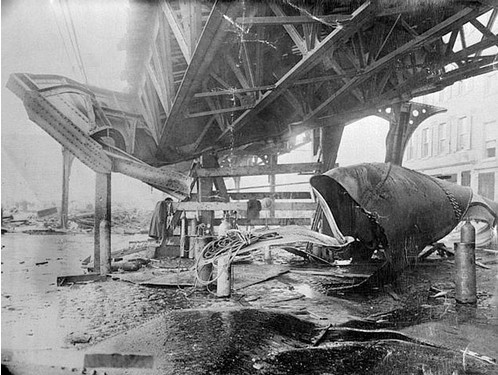Americana: Massachusetts
01 - 19 Sep 2009
AMERICANA: MASSACHUSETTS
The Great Molasses Flood
Mary Augustine Gallery | Sept. 1–19, 2009
On January 15th, 1919 at 12:45pm, a 50-foot tall tank of molasses suddenly broke apart on the Boston waterfront. Sending over two million gallons of the sticky liquid racing through the city streets, large waves knocked a brick firehouse off its foundation and crushed several small buildings, along with other significant damage. The accident killed 21 people and injured 150 others resulting in a class action lawsuit against the tank's owner, United States Industrial Alcohol (USIA), and a trial lasting nearly five years.
In the early 1900s, Massachusetts was a hotbed for radical politics, with Italian anarchists being among the most active and outspoken. Between 1880 and 1921, more than 4.2 million Italian immigrants entered the United States, primarily via Ellis Island in New York. This rapid influx led to intense xenophobia in the Northeast states, which fueled, and was in turn fueled by, radical leftist politics of the marginalized immigrant classes. In 1903, the radical Italian anarchist newspaper Cronaca Sovverisiva (Subversive Chronicle) was founded by Luigi Galleani on the outskirts of Boston. His followers, the Galleanisti, were convicted of carrying out dozens of deadly bombing campaigns in the Northeast. These activities had a marked effect on the perception of immigrants, Italians in particular, in the US. The fear of radical immigrant activity was channeled directly into legislation that affected all immigrants in the United States for decades. Mere months before the flood, the Immigration Act, also known as the Anarchist Exclusion Act, was passed, which permitted the US government to prevent the immigration of anarchists, as well as to arrest and deport suspected immigrant political radicals. In the following years 556 accused or admitted anarchists were deported including Luigi Galleani and several of his supporters.
The molasses in the 3-story high tank was stored in an area of Boston known for anarchist activity. When faced with the class action lawsuit from the flood victims, USIA constructed a defense around the idea that a lone anarchist had dropped a bomb inside the tank. This defense deliberately preyed on prevalent fears of anarchist activity. The USIA defense conveniently disregarded the shoddy construction of the tank and the fact that it had been leaking badly since the day it was built. Ultimately, this preposterous defense was disproved and USIA was forced to pay $30,000 in damages (approximately $30 million today) to the victims.
The molasses flood serves as a valuable historic entry point for examining key issues that have continued relevance today, including xenophobia and discrimination towards immigrants, domestic terrorism, and free speech in a time of crisis.
Curated by Katie Hood Morgan
The Great Molasses Flood
Mary Augustine Gallery | Sept. 1–19, 2009
On January 15th, 1919 at 12:45pm, a 50-foot tall tank of molasses suddenly broke apart on the Boston waterfront. Sending over two million gallons of the sticky liquid racing through the city streets, large waves knocked a brick firehouse off its foundation and crushed several small buildings, along with other significant damage. The accident killed 21 people and injured 150 others resulting in a class action lawsuit against the tank's owner, United States Industrial Alcohol (USIA), and a trial lasting nearly five years.
In the early 1900s, Massachusetts was a hotbed for radical politics, with Italian anarchists being among the most active and outspoken. Between 1880 and 1921, more than 4.2 million Italian immigrants entered the United States, primarily via Ellis Island in New York. This rapid influx led to intense xenophobia in the Northeast states, which fueled, and was in turn fueled by, radical leftist politics of the marginalized immigrant classes. In 1903, the radical Italian anarchist newspaper Cronaca Sovverisiva (Subversive Chronicle) was founded by Luigi Galleani on the outskirts of Boston. His followers, the Galleanisti, were convicted of carrying out dozens of deadly bombing campaigns in the Northeast. These activities had a marked effect on the perception of immigrants, Italians in particular, in the US. The fear of radical immigrant activity was channeled directly into legislation that affected all immigrants in the United States for decades. Mere months before the flood, the Immigration Act, also known as the Anarchist Exclusion Act, was passed, which permitted the US government to prevent the immigration of anarchists, as well as to arrest and deport suspected immigrant political radicals. In the following years 556 accused or admitted anarchists were deported including Luigi Galleani and several of his supporters.
The molasses in the 3-story high tank was stored in an area of Boston known for anarchist activity. When faced with the class action lawsuit from the flood victims, USIA constructed a defense around the idea that a lone anarchist had dropped a bomb inside the tank. This defense deliberately preyed on prevalent fears of anarchist activity. The USIA defense conveniently disregarded the shoddy construction of the tank and the fact that it had been leaking badly since the day it was built. Ultimately, this preposterous defense was disproved and USIA was forced to pay $30,000 in damages (approximately $30 million today) to the victims.
The molasses flood serves as a valuable historic entry point for examining key issues that have continued relevance today, including xenophobia and discrimination towards immigrants, domestic terrorism, and free speech in a time of crisis.
Curated by Katie Hood Morgan

